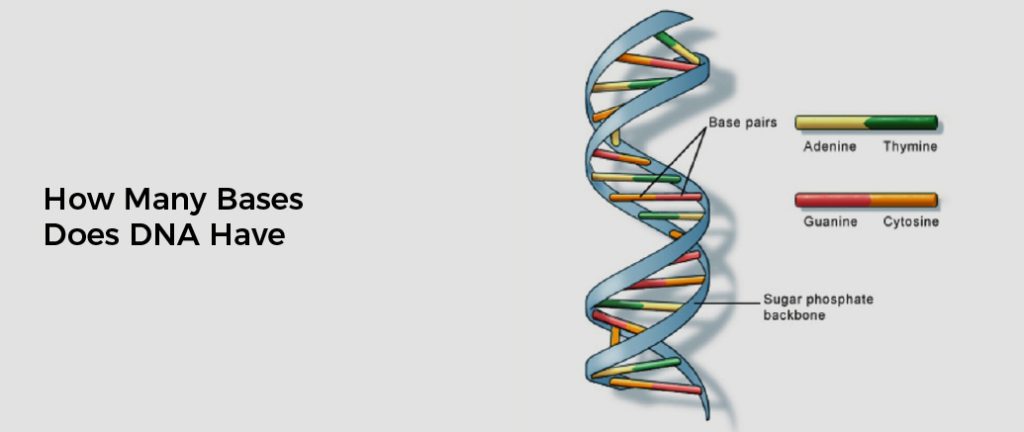How many bases does DNA have: The number of bases in a DNA strand varies depending on the organism and the specific location in the genome. The human genome generally has around 3 billion base pairs, and most other organisms have a similar number of base pairs. It’s worth noting that the number of base pairs can change over time due to mutations, which can be beneficial, neutral, or harmful to the organism.
In this blog, we will give you detailed components of DNA that make the DNA genetic material of human beings. And amaze you how nature works for the human world.
BASIC TERMS
- DNA is a double-stranded macromolecule consisting of two complementary strands. These strands are joined together by base pairs.
- A Chromosome is a complex macromolecule, and its structure is made up of a double helix. It is very long and is coiled around proteins called histones. The length of a DNA molecule varies, but when unraveled, it is about six feet.
- Non-coding DNAis a term that describes genetic material that doesn’t encode protein sequences. Although noncoding DNA is mainly unstudied, researchers are beginning to understand its importance.
- DNA packagingis the process of packaging genetic material into chromosomes. The human genome has approximately 3 billion base pairs, which is a little less than 1.8 meters long.
What is DNA?
DNA is a double-stranded macromolecule consisting of two complementary strands. These strands are joined together by base pairs. Each strand has its own sequence of nucleotides. Those sequences can be copied to form a new strand called replication.
There are four different types of nucleotides in DNA bases: adenine (A), guanine (G), cytosine (C), and thymine (T). All of them are nitrogenous bases, which have their own special chemical properties. They pair in a specific way, forming chemical bonds that are like ladder rungs.
The number of base pairs in a DNA molecule ranges from hundreds of thousands to millions. Moreover, a DNA molecule with more G-C base pairs will have more hydrogen bonds, which will give the strand more stability. This means that it will decompose more slowly.
What are the BasesMakeup DNA?
DNA is composed of four types of nucleotides: adenine (A), thymine (T), cytosine (C), and guanine (G). These nucleotides are linked together in a specific order to form a double helix structure. The sequence of these nucleotides contains the genetic information that is passed down from parent to offspring and directs the development and function of all living organisms.
How is the DNA Strand Organized?
DNA is organized into a double helix structure. The two strands of the helix run in opposite directions and are held together by hydrogen bonds between the nitrogenous bases. Adenine (A) on one strand pairs with thymine (T) on the other strand, and cytosine (C) pairs with guanine (G). While the sequence of these base pairs along the DNA strand length encodes the genetic information.
The DNA is also packaged in the cell, with the help of histone proteins, into structures called chromosomes. Moreover, chromosomes are found in the nucleus of eukaryotic cells and carry the genetic information for an organism. For example, there are 23 pairs of chromosomes in human cells, for a total of 46.
How is DNA Packaged Inside Cells?
DNA packaging is the process of packaging genetic material into chromosomes. The human genome has approximately 3 billion base pairs, which is a little less than 1.8 meters long.
To fit in a cell, the DNA must be organized in a way that does not disrupt the DNA’s sequence. There are several different levels of packaging. In the first level, the DNA is wound around a protein core.
This structure, called a nucleosome, is made up of eight proteins known as histones. These histones have the ability to bind to negatively charged DNA to balance out the charge. While they are involved in controlling the expression of genes.
During the cell division process, chromatin is further condensed into a chromosome. Chromatids are loops of chromatin that form the structural basis of chromosomes.
During this process, the entire length of the DNA strand must be able to fit in the nucleus. Because DNA is highly dense, a cell must use stringent packaging rules to ensure that the DNA does not become damaged.
Non-Coding DNA
Non-coding DNA is a term that describes genetic material that doesn’t encode protein sequences. Although noncoding DNA is largely unstudied, researchers are beginning to understand its importance. It provides instructions for the formation of specific RNA molecules and helps to regulate gene activity.
While there are many different types of noncoding DNA, a number of them have a clear functional role. For example, the centromere is a type of noncoding sequence that has been known for almost half a century.
Transposons are the largest category of noncoding DNA, accounting for about half of the human genome. Transposons are genetic elements that copy themselves and change location within the genome. They can copy hundreds of thousands of times. However, the biological benefit of such proliferation is still unclear.
Other types of noncoding sequences include introns. Introns are regions of the genome that do not encode protein sequences. Researchers are working to understand the role of introns and how they might help accelerate gene evolution.


